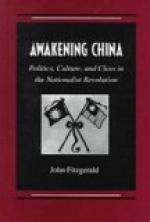Passing from the Chinese city through the Great Central Gate we enter Legation Street, so called because most of the legations are situated on or near it. Architecturally they make no show, being of one story, or at most two stories, in height and hidden [Page 37] behind high walls. So high and strong are the walls of the British Legation that in the Boxer War of 1900 it served the whole community for a fortress, wherein we sustained a siege of eight weeks. A marble obelisk near the Legation gate commemorates the siege, and a marble gateway on a neighbouring street marks the spot where Baron Ketteler was shot. Since that war a foreign quarter has been marked out, the approaches to which have been partially fortified. The streets are now greatly improved; ruined buildings have been repaired; and the general appearance of the old city has been altered for the better.
Two more walled enclosures have to be passed before we arrive at the palace. One of them forms a protected barrack or camping-ground for the palace guards and other officials attendant on the court. The other is a sacred precinct shielded from vulgar eyes and intrusive feet, and bears the name “Forbidden City.” In the year following the flight of the court these palaces were guarded by foreign troops, and were thrown open to foreign visitors.
Marble bridges, balustrades, and stairways bewilder a stranger. Dragons, phoenixes and other imaginary monsters carved on doorways and pillars warn him that he is treading on sacred ground. The ground, though paved with granite, is far from clean; and the costly carvings within remind one of the saying of an Oriental monarch, “The spider taketh hold with her hands and is in kings’ houses.” None of the buildings has more than one story, but the throne-rooms and great halls are so lofty as to suggest the dome of a cathedral. The roofs are all covered with tiles of a [Page 38] yellow hue, a colour which even princes are not permitted to use.
Separated from the palace by a moat and a wall is Prospect Hill, a charming elevation which serves as an imperial garden. On the fall of the city in 1643 the last of the Mings hanged himself there—after having stabbed his daughter, like another Virginius, as a last proof of paternal affection.
From the gate of the Forbidden City to the palace officials high and low must go on foot, unless His Majesty by special favour confers the privilege of riding on horseback, a distinction which is always announced in the Gazette by the statement that His Majesty has “given a horse” to So-and-So. No trolleys are to be seen in the streets, and four-wheeled carriages are rare and recent. Carts, camels, wheel-barrows, and the ubiquitous rickshaw are the means of transport and locomotion. The canals are open sewers never used for boats.
Not lacking in barbaric splendour, as regards the convenience of living this famous capital will not compare with a country village of the Western world. On the same parallel as Philadelphia, but dryer, hotter, and colder, the climate is so superb that the city, though lacking a system of sanitation, has a remarkably low death-rate. In 1859 I first entered its gates. In 1863 I came here to reside. More than any other place on earth it has been to me a home; and here I am not unlikely to close my pilgrimage.




